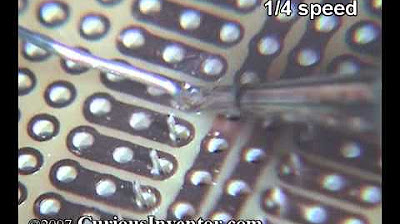5 MISTAKES that DESTROY the tip of your SOLDERING IRON!
Summary
TLDRThis video script provides essential tips on maintaining your soldering iron to extend the lifespan of its tip. It highlights five common mistakes, such as sanding the tip, using excessive heat, and improper cleaning, which can cause oxidation and shorten the tool's life. The speaker emphasizes the importance of proper storage, cleaning, and handling techniques, including avoiding high temperatures and using the right type of cleaning sponge. Additionally, the script promotes an advanced soldering course for those looking to enhance their skills in electronic soldering and repairs. With these tips, you can save money, reduce tool wear, and improve soldering efficiency.
Takeaways
- 😀 Avoid sanding the tip of your soldering iron with a file or sandpaper, as it removes essential protective layers like tin and chrome, making the tip more prone to oxidation.
- 😀 Do not use the tip of your soldering iron to melt plastic, as this can lead to faster oxidation of the tip.
- 😀 Always clean and tin the tip of your soldering iron before storing it to prevent oxidation and prolong its life.
- 😀 Be cautious with the type of cleaning sponge used—avoid using a dry or overly wet vegetal sponge as it can cause damage to the tip due to temperature changes or friction.
- 😀 Excessive heat, especially above 350°C, should be avoided unless absolutely necessary, as prolonged high temperatures accelerate oxidation of the tip.
- 😀 Turn off your soldering iron when not in use. Letting it stay on for long periods unnecessarily can reduce the lifespan of the tip.
- 😀 Handle your soldering iron gently—avoid hitting the tip or being too aggressive when soldering, as impacts can cause the tip to deteriorate faster.
- 😀 Invest in high-quality soldering iron tips. They may be more expensive, but they last much longer, saving money in the long run.
- 😀 Regularly check the condition of your soldering iron's tip and take necessary steps like re-tinning to maintain its effectiveness.
- 😀 Learning the proper techniques for soldering, like using correct temperatures and tools, is crucial for ensuring the longevity of your soldering iron and achieving quality results.
Q & A
Why does the soldering iron tip become black and oxidized?
-The tip becomes black and oxidized due to high temperatures and exposure to oxygen in the air. The metals in the tip, such as copper, iron, chrome, and tin, react with oxygen and begin to degrade, leading to oxidation and loss of material.
What happens when you use sandpaper or a file on the soldering iron tip?
-Using sandpaper or a file removes the protective layers of tin and chrome from the tip, which are designed to prevent oxidation. This makes it harder for the solder to adhere and causes the tip to oxidize more quickly.
Why should you avoid using the soldering iron tip on plastic?
-Using the tip on plastic causes it to melt, which increases the rate of oxidation and wears down the tip much faster. The soldering iron tip is designed solely for soldering tin and should not come into contact with other materials like plastic.
What is the correct way to store a soldering iron after use?
-After use, the tip should be cleaned lightly with a metal sponge and tin should be applied in a thin layer to protect it. The soldering iron should be turned off and stored properly to avoid further oxidation.
What happens if you use a dry or overly wet sponge to clean the soldering iron tip?
-A dry sponge will burn and damage the tip, while an overly wet sponge can cause a rapid temperature drop, leading to cracking and separation of the protective layers. A slightly damp sponge is ideal for cleaning the tip.
What temperature should the soldering iron be set to for most electronic soldering tasks?
-For most electronic soldering tasks, a temperature range of 300 to 350°C is sufficient. Higher temperatures, like 450°C or 480°C, should only be used when necessary, as they increase oxidation and wear on the tip.
How can using high temperatures for too long damage the soldering iron tip?
-Using high temperatures for extended periods accelerates the oxidation process, causing the tip to degrade faster. This is because the metal tip is more exposed to the effects of heat and oxygen at higher temperatures.
What should you do if you accidentally drop the soldering iron or apply excessive force?
-Dropping the soldering iron or applying excessive force can cause the tip to bend, break, or detach its protective layers, leading to quicker oxidation and damage. Handle the soldering iron carefully to prevent these issues.
Why is it recommended to buy high-quality soldering iron tips?
-High-quality tips are designed to last longer and withstand the stresses of frequent use. While they might be more expensive upfront, they provide better performance, saving money in the long term as they do not need to be replaced as often.
What is the importance of applying a thin layer of tin to the soldering iron tip before storing it?
-Applying a thin layer of tin helps to protect the tip from oxidation. It forms a protective layer that prevents oxygen from coming into contact with the metal, preserving the tip and ensuring better soldering performance in the future.
Outlines

This section is available to paid users only. Please upgrade to access this part.
Upgrade NowMindmap

This section is available to paid users only. Please upgrade to access this part.
Upgrade NowKeywords

This section is available to paid users only. Please upgrade to access this part.
Upgrade NowHighlights

This section is available to paid users only. Please upgrade to access this part.
Upgrade NowTranscripts

This section is available to paid users only. Please upgrade to access this part.
Upgrade Now5.0 / 5 (0 votes)





